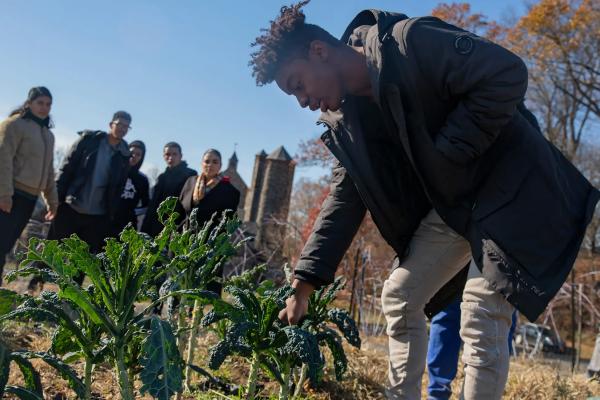Sustainable Schools at Work: High School for Environmental Studies, NYC
While HSES has always had an environmental focus, exposure to the United Nations’ 17 Sustainable Development Goals at our Foundations in Education for Sustainability program inspired school leadership to rethink their definition of environmentalism. “It helped us clarify the work we were already doing and how we could build on it,” says assistant principal Michael Lipkowitz. With ongoing, multi-year support from Institute educators, the collaboration has “helped us clarify different projects we were working on and think about how we wanted to shift our focus moving forward,” says Lipkowitz.
On a (New) Mission
“Once I had an idea of what the larger picture should look like, we really defined our mission and our vision based on sustainability,” says former school principal Amber Najmi-Shadid. Today, that revised mission is:
“…to promote environmental integrity, social equity and economic prosperity for all learners through challenging hands-on collaborative learning experiences that promote citizenship, scholarship and leadership within our community and the world at large.”
The school began to realign to support this new mission and connect teachers’ passions to it, all part of an approach known as Education for Sustainability (EFS). Sustainability became the unifying theme for HSES’ integrated, dynamic curriculum, which centers its 1,300 students by providing opportunities for action and hands-on learning in the local community. “What really imprinted on me from Shelburne Farms was the idea of place-based learning, and the importance and value of that,” said teacher and professional learning alum David Johnson. “That retreat made me realize that [place-based learning] often comes from direct experience in your neighborhood.”
Here’s the power of EFS: Starting with building their knowledge of and experience with the natural and human communities in which they live, students grow to understand the connections with broader systems and begin to see themselves as active citizens, with the ability to participate and make positive contributions. As one student explains:
“I find learning history and acknowledging the mistakes of our generation and past generations is really important to become a local, national, and global citizen. It is incredibly important to know the place and impact you hold on the world as you live. At HSES, through classes and meetings, I am constantly encouraged to reflect on my place in the world and how I can impact my environment. All of the knowledge and understanding I gain will allow me to be a global citizen that can make great changes in the world.”
Sustainability in Action
Today, sustainability is alive at HSES through a rigorous curriculum, infused with opportunities to contribute to the community. Teachers are able to follow their passions and bring academic content to life by connecting it with real-world and relevant local and global issues.
Curriculum: The goal at HSES is to weave sustainability themes as much as possible into all classes, from math and chemistry to writing, and to connect classwork to experiences relevant to students. One example: Inspired by professional development in EFS, the environmental writing teacher refocused the curriculum on food and food justice, “finding ways to tie in what we do in the classroom to what’s going on in the city and what’s going on in the larger world.” One math teacher developed the algebra curriculum so that “each unit has a project that goes along with it, that relates to the real world in some way,” topics including heart rate, population, college admissions, and gender and racial representation in STEM.
Student Voice: Student voice is about educators listening to and acting on the interests, opinions, perspectives, and insights that students offer about their educational choices and experiences. Research shows increasing students’ agency in their education can increase engagement and motivation, improvement in decision making, understanding of responsibility, and preparation for civic participation. Said one student, “I feel like I actually have a voice in my education. I feel heard when I’m at HSES. This has an impact on how I feel about my education.”
Community Partnerships: Ongoing partnerships with community organizations are vital to connecting the curriculum to relevant, real-world issues and are opportunities for students to participate and contribute. HSES’ partners include conservation-focused NGOs, arts and cultural institutions, colleges and universities, farms, and social service organizations. As the school has begun to build and strengthen its farm to school program, a partnership with a local food justice organization has been particularly successful and enriching for students. In one service-learning project, students led a partnership with a local soup kitchen, from soliciting food donations from local markets and restaurants and preparing food to inviting community members, serving meals, interviewing guests for a podcast about food insecurity, and using project management software to keep track of it all. As the teacher involved with the project described, “To really be a part of that type of professional experience that you would find in a company or in a nonprofit...was very powerful for the kids.”
Campus Sustainability Practices and Culture: HSES dug into practices to directly address environmental sustainability, including composting, recycling, and food production. Administrators also addressed aspects of school culture to take a closer look at economic and social justice issues. A school administrator described that with respect to EFS, his “work has been more systemic changes.” The school has a strong internship program, now built around a centralized platform where students can easily access information about available opportunities that previously was much harder to track down.
True Partnership
In the years since HSES teachers and administrators attended professional learning at Shelburne Farms, we’ve continued a strong partnership with HSES. Today, our educators nurture their work, including connecting with students to support sustainability projects and providing ongoing professional development for HSES teachers.
The students and teachers at HSES are a powerful example of the promise of Education for Sustainability. In the words of one HSES student:
“When I say HSES is different, it is different in the sense that its core values really guide the activities in the school and even the curriculum. The classes always make you think critically about your place in the world and the environment and allow you to make connections with your surroundings in meaningful ways…I am proud to say that my school doesn’t just want us to learn, it wants to shape us and motivate us to have the confidence to use the tools around us to fight for justice and combat global issues no matter the place we step into or the setbacks we might face along the way.”
This story was based on an independent research report by PEER Associates. Read the full report.
Photos sourced from The New York Times, featured in a 2019 article on the HSES curriculum.

